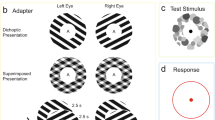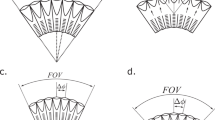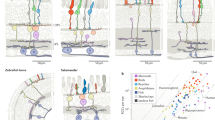Abstract
EXNER'S theory of the formation of a retinal image by superposition1 in certain arthropod compound eyes requires that an object in front of a number of ommatidia is twice inverted by the dioptric system of each ommatidium. Thus erect images of the object are formed behind the crystalline cones. Converging proximally, those images grow in size and superimpose in the layer of the receptive structures, the rhabdoms. Exner tested his theory by observing the image formation in sectioned eyes and found agreement between experiment and theory in more than a dozen insect species. His findings were confirmed repeatedly using the firefly2–4. (Although Exner proposed the formation of superposition images in certain Crustacean eyes, he failed to obtain upright and superposition images. So did other observers2,3. Crustacea will therefore be excluded.)
This is a preview of subscription content, access via your institution
Access options
Subscribe to this journal
Receive 51 print issues and online access
$199.00 per year
only $3.90 per issue
Buy this article
- Purchase on Springer Link
- Instant access to full article PDF
Prices may be subject to local taxes which are calculated during checkout
Similar content being viewed by others
References
Exner, S., Die Physiologie der facettierten Augen von Krebsen und Insekten (Franz Deuticke, Leipzig and Vienne, 1891).
Nunnemacher, R. F., Anat. Rec., 134, 618 (1959).
Kuiper, J. W., Symp. Soc. Exp. Biol., 16, 58 (1962).
Winthrop, J. T., and Worthington, C. R., Biophys. J., 6, 124P (1966).
Horridge, G. A., Nature, 218, 778 (1968).
Horridge, G. A., Proc. Roy. Soc., B, 171, 445 (1969).
Miller, W. H., Bernard, G. D., and Allen, J. L., Science, 162, 760 (1968).
Kirschfeld, K., Exp. Brain Res., 3, 248 (1967).
Leydig, F., Das Auge der Gliederthiere (Tübinger Universitätsschr., Tübingen: Laupp, 1864).
Author information
Authors and Affiliations
Rights and permissions
About this article
Cite this article
KUNZE, P. Eye Glow in the Moth and Superposition Theory. Nature 223, 1172–1174 (1969). https://doi.org/10.1038/2231172a0
Received:
Revised:
Issue Date:
DOI: https://doi.org/10.1038/2231172a0
This article is cited by
-
Neither apposition nor superposition: the compound eyes of the Chestnut Leafminer Cameraria ohridella
Zoomorphology (2012)
-
Image quality and acceptance angle in a reflecting superposition eye
Journal of Comparative Physiology ? A (1983)
-
The superposition image in the eye ofEphestia k�hniella
Journal of Comparative Physiology ? A (1977)
-
Optische Untersuchungen an der Cornea der MehlmotteEphestia k�hniella
Journal of Comparative Physiology (1974)
-
Comparative studies of arthropod superposition eyes
Zeitschrift f�r Vergleichende Physiologie (1972)
Comments
By submitting a comment you agree to abide by our Terms and Community Guidelines. If you find something abusive or that does not comply with our terms or guidelines please flag it as inappropriate.



